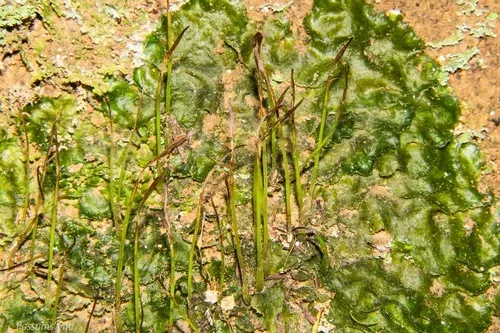
10-Megaceros-flagellaris-6-7-Gametophyte-8-Thalli-with-sporophytes-9-Epidermal.png from: https://www.researchgate.net/figure/10-Megaceros-flagellaris-6-7-Gametophyte-8-Thalli-with-sporophytes-9-Epidermal_fig3_309632968
Megaceros flagellaris: The Fascinating Whip-Horned Moss

495301BD589B42529A3871BADD31A40E.jpeg from: https://www.picturethisai.com/de/wiki/Megaceros_flagellaris.html

megaceros.jpg from: https://musee-prehistoire-eyzies.fr/musees-napoleonien-africain/collection/objet/megaceros

15741161306_1f2d3949ae_b.jpg from: https://www.flickr.com/photos/scottzona/15741161306
Introduction
Today we’re diving into the wonderful world of Megaceros flagellaris (Mitt.) Steph., a unique moss species in the Dendrocerotaceae family. Also known simply as Megaceros, this moss is sure to captivate any botany enthusiast with its distinctive features and ecological roles. Let’s explore what makes Megaceros flagellaris so special!
Background on Megaceros

largepreview.png from: https://www.researchgate.net/publication/303329548_Sporophyte_anatomy_of_Megaceros_flagellaris_Dendrocerotaceae
Megaceros flagellaris is a species of hornwort, which are non-vascular plants in the division Anthocerotophyta. Hornworts get their name from the elongated horn-like structure called a sporophyte that grows from the gametophyte plant. There are around 200-250 species of hornworts worldwide.
The genus Megaceros

16-Notothylas-javanica-11-Distal-face-of-the-spore-showing-finely-vermiculate_Q640.jpg from: https://www.researchgate.net/figure/27-Megaceros-flagellaris-22-Gametophyte-23-Gametophyte-with-sporophytes-24_fig5_309632968
contains around 30 species found in tropical and south temperate regions. The specific epithet “flagellaris” comes from Latin meaning “whip-like”, referring to the very long, slender sporophytes of this species which can reach

default.jpg from: https://wellcomecollection.org/works/khu8uekk
8 cm or more in length.
Morphology and Identification
M. flagellaris forms dense mats of bright green, lobed thalli (leaf-like structures). The thalli are relatively large for a hornwort, reaching

ca8991ddcf1cd089eb2e61ceae7ac07f_1347239a379adb20f901e14e22785809.jpg from: https://displate.com/displate/3998724
2-5 cm in diameter. Oil bodies are present in the thallus cells which appear as dark spots.
The most distinctive feature is the extremely long, whip-like sporophytes that emerge from the thalli. These consist of a foot embedded in the gametophyte, an elongated seta (stalk), and a slender capsule containing spores. The sporophytes can be 10 times longer than the thallus!
Global Distribution and Habitat
Megaceros flagellaris
Megaceros-chioroplasts-A-M-leptohymenius-B-M-flagellaris-No-pyrenoids-are-found.ppm from: https://www.researchgate.net/figure/Megaceros-chioroplasts-A-M-leptohymenius-B-M-flagellaris-No-pyrenoids-are-found_fig7_239730345
has a wide distribution across the tropics and subtropics. It is found in Central and South America, Africa, Asia, Australia, and many Pacific islands. The species typically grows on damp soil, rocks, and rotting logs in humid forests and along streams from lowlands to mountains.
Ecological Roles and Adaptations
As a hornwort, M. flagellaris
1200 from: https://walkingwith.fandom.com/wiki/Megaloceros
plays important ecological roles:
- Pioneers on disturbed soils
- Provide erosion control
- Contribute to nutrient cycling
- Act as a carbon sink
- Provide microhabitats for invertebrates
The thalli can dry out and rehydrate quickly, an adaptation to wetting and drying cycles. The long sporophytes help disperse spores further in the wind. Some hornworts also have cyanobacterial symbionts that fix atmospheric nitrogen.
Conclusion
Megaceros flagellaris is a prime example of the amazing diversity and adaptations found in mosses and hornworts. From its whip-like sporophytes to its mat-forming thalli, this species illustrates the important and often overlooked roles these tiny plants play in ecosystems worldwide. What other fascinating bryophyte species have you encountered?